
A carronade is a short, smoothbore, cast-iron cannon which was used by the Royal Navy. It was first produced by the Carron Company, an ironworks in Falkirk, Scotland, and was used from the mid-18th century to the mid-19th century. Its main function was to serve as a powerful, short-range, anti-ship and anti-crew weapon. The technology behind the carronade was greater dimensional precision, with the shot fitting more closely in the barrel thus transmitting more of the propellant charge's energy to the projectile, allowing a lighter gun using less gunpowder to be effective. Carronades were initially found to be very successful, but they eventually disappeared as naval artillery advanced, with the introduction of rifling and consequent change in the shape of the projectile, exploding shells replacing solid shot, and naval engagements being fought at longer ranges.

Steam frigates and the smaller steam corvettes, steam sloops, steam gunboats and steam schooners, were steam-powered warships that were not meant to stand in the line of battle. There were some exceptions like for example the French Napoléon class steam ship of the line was meant to stand in the line of battle, making it the world's first steam battleship. The first such ships were paddle steamers. Later on the invention of screw propulsion enabled construction of steam-powered versions of the traditional ships of the line, frigates, corvettes, sloops and gunboats.

The rating system of the Royal Navy and its predecessors was used by the Royal Navy between the beginning of the 17th century and the middle of the 19th century to categorise sailing warships, initially classing them according to their assigned complement of men, and later according to the number of their carriage-mounted guns. The rating system of the Royal Navy formally came to an end in the late 19th century by declaration of the Admiralty. The main cause behind this declaration focused on new types of gun, the introduction of steam propulsion and the use of iron and steel armour which made rating ships by the number of guns obsolete.
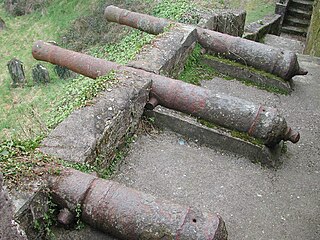
The first usage of cannon in Great Britain was possibly in 1327, when they were used in battle by the English against the Scots. Under the Tudors, the first forts featuring cannon batteries were built, while cannon were first used by the Tudor navy. Cannon were later used during the English Civil War for both siegework and extensively on the battlefield.

HMS Griffin was a 28-gun Coventry-class sixth-rate frigate of the Royal Navy.
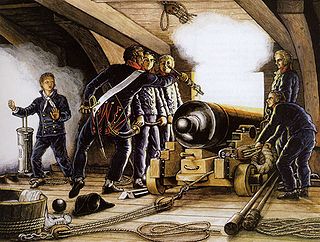
The 18-pounder long gun was an intermediary calibre piece of naval artillery mounted on warships of the Age of Sail. They were used as main guns on the most typical frigates of the early 19th century, on the second deck of third-rate ships of the line, and even on the third deck of late first-rate ships of the line.

The 12-pounder long gun was an intermediary calibre piece of artillery mounted on warships of the Age of sail. They were used as main guns on the most typical frigates of the early 18th century, on the second deck of fourth-rate ships of the line, and on the upper decks or castles of 80-gun and 120-gun ships of the line. Naval 12-pounders were similar to 12-pound Army guns in the Gribeauval system: the canon lourd de 12 Gribeauval, used as a siege weapon, and the canon de 12 Gribeauval, which was considered a heavy field artillery piece.
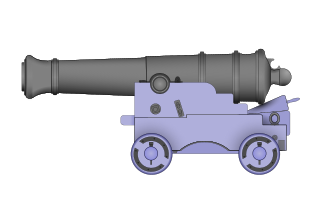
The 30-pounder long gun was a large piece of artillery mounted on French warships of the Age of sail. They were the heaviest component of the unified system standardised on the 30-pounder calibre, replacing both the 36-pounder long guns in their usages, and even some 24-pounders.
The 30-pounder short gun was a piece of artillery mounted on French warships of the Age of sail. They were the middle-sized component of the unified system standardised on the 30-pounder calibre, replacing both the 24-pounders and 18-pounders in many usages.

HMS Perseverance was a 36-gun Perseverance-class frigate of the British Royal Navy. She served on the North American station until 1787, after which she returned to England, where she was refitted at Portsmouth. In 1789 Perseverance was sent to the East Indies; she returned to Portsmouth in 1793, when she was laid up before finishing her career there as a receiving ship. She was sold and broken up in May 1823.
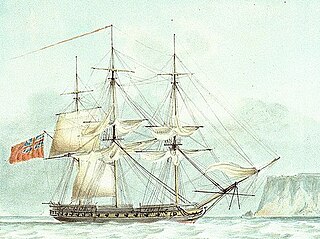
HMS Lavinia was a 44-gun fifth-rate frigate of the Royal Navy, launched in 1806 at Milford Haven. She was 1,17167⁄94 tons burthen and carried a main battery of thirty 18-pounder (8.2 kg) guns on the upper deck with a secondary armament of eight 9-pounder (4.1 kg) guns and twelve 32-pounder (15 kg) carronades.
Rostislav was an 84-gun third-rate ship of the line built for the Black Sea Fleet of the Imperial Russian Navy in the 1840s as part of a naval expansion program to strengthen the fleet during a period of increased tension with Britain and France. Rostislav carried a battery primarily consisting of traditional shot-firing guns, but she also carried eight new shell-firing guns. The ship saw combat during the Crimean War at the Battle of Sinop in 1853, where the Russian shell guns proved to be decisive. She repaired in Sevastopol in 1854 and was scuttled during the Siege of Sevastopol in 1855.
Chesma was an 84-gun ship of the line built for the Black Sea Fleet of the Imperial Russian Navy in the 1840s. Chesma carried a battery primarily consisting of tradition shot-firing guns, but she also carried four new shell-firing guns. The ship saw combat during the Crimean War at the Battle of Sinop against an Ottoman squadron in 1853, where the Russian shell guns proved to be decisive. The battle prompted Britain and France to intervene to support the Ottomans, leading the Russian fleet to withdraw to Sevastopol to avoid a battle with an Anglo-French fleet. Chesma helped to defend Sevastopol, supporting Russian ground forces during a battle in February 1855 before being disarmed to strengthen the city's defenses and then scuttled to block the harbor entrance to the Anglo-French fleet in August.

Khrabryi was the lead ship of the Khrabryi class of ships of the line built for the Black Sea Fleet of the Imperial Russian Navy in the 1840s. She saw limited service during the Crimean War in 1853–1854; storm damage prevented her from participating in the Battle of Sinop, and the Russian fleet thereafter avoided battle with the British and French fleets that intervened on behalf of the Ottoman Empire. Disarmed during the Siege of Sevastopol, she was later scuttled there to block the harbor entrance in 1855.

The Khrabryi class was a pair of ships of the line built for the Black Sea Fleet of the Imperial Russian Navy in the 1840s and early 1850s. The class comprised two ships: Khrabryi and Imperatritsa Maria. The two ships were built as part of a naval expansion program aimed at strengthening the Black Sea Fleet during a period of increased tension with Britain and France over the continued decline of the Ottoman Empire. Both ships saw active service during the Crimean War, with Imperatritsa Maria serving as Pavel Nakhimov's flagship at the Battle of Sinop in November 1853, where the Russians annihilated an Ottoman squadron. The two ships were withdrawn to Sevastopol after the British and French intervention and were trapped there during the Siege of Sevastopol until 1855, when both were scuttled to block the harbor entrance.

Sviatoslav was a Sultan Makhmud-class ship of the line built for the Imperial Russian Navy's Black Sea Fleet in the 1840s. The ship participated in the Crimean War in 1853–1855, beginning with an operation to carry reinforcements for the Imperial Russian Army stationed in the Caucasus in October 1853. Storm damage prevented her from taking part in the Battle of Sinop the next month, but the British and French intervention in the war after that battle led ultimately to Sviatoslav's loss. The Russian fleet withdrew to Sevastopol to avoid battle with the Anglo-French fleet, and during the ensuing Siege of Sevastopol, she was converted into a hospital ship and eventually scuttled in February 1855.

Iagudiil was a Sultan Makhmud-class ship of the line built for the Imperial Russian Navy's Black Sea Fleet in the 1840s. Iagudiil had an uneventful career in the 1840s, alternating between periods in commission and in reserve. She participated in the early operations of the Black Sea Fleet during the Crimean War in October 1853, but her poor condition kept her from seeing action at the Battle of Sinop. The French and British intervention after Sinop led to the Russian retreat to Sevastopol, which was then besieged from 1854 to 1855. During the siege, Iagudiil battled French and British field artillery. After the Russian defenders were defeated in August 1855, they burned the ship to prevent it from being captured by the British and French, and the wreck was later demolished in 1857.

Uriil was a Sultan Makhmud-class ship of the line built for the Imperial Russian Navy's Black Sea Fleet in the late 1830s and early 1840s. The ship had a relatively uneventful career, operating with the Black Sea Fleet in the early 1840s before being laid up in 1845; apart from brief periods of activity in 1847 and 1849, she remained out of service until 1852. After the outbreak of the Crimean War in October 1853, she joined a squadron commanded by Pavel Nakhimov, but was unable to participate in the Battle of Sinop after a storm opened leaks in her hull. In poor condition, she was removed from service and her crew was sent to help man shore batteries during the Siege of Sevastopol. Uriil was then scuttled to block the harbor entrance in 1854.

The 32-pounder guns were sets of heavy-caliber pieces of artillery mounted on warships in the last century of the Age of sail, during the 18th and early 19th centuries. It was usually the most powerful armament on a warship. The British version fired a 14.4 kilogram projectile at about 487 meters per second, for a muzzle energy of over 1.7 million joules. They were most famous being mounted on HMS Victory of the Royal Navy. Such a powerful gun with a large weight of shot posed serious damage to enemy ships.
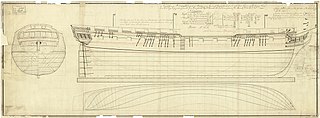
Aigle-class frigates were 36-gun sailing frigates of the fifth rate designed by Surveyor of the Navy, Sir John Henslow for the Royal Navy. Only two were built: HMS Aigle and HMS Resistance. Aigle was ordered first on 15 September 1798 but a 16-month delay during her construction meant that Resistance was completed and launched first on 29 April 1801.














